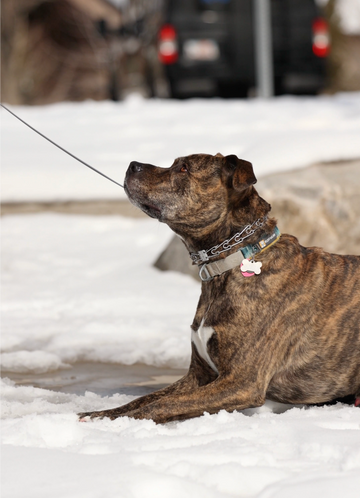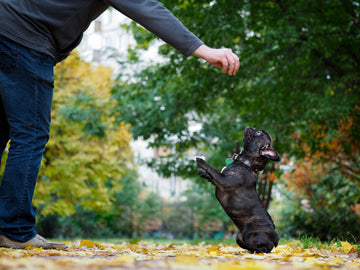Few tools in the dog training world stir up as much debate as the prong collar—also called the pinch collar. Mention it in a room full of dog lovers and you're bound to get a spectrum of reactions, from enthusiastic support to passionate opposition. Often grouped with e-collars as one of the most controversial training aids out there, the prong collar has earned a reputation that’s part misunderstood, part misused—and completely worth discussing.
So, what is it about prong collars that ruffles feathers? Are they truly dangerous, or simply misunderstood? Can they be used safely and humanely? If you’ve ever found yourself wondering, you’re not alone—and we’re here to unpack it all.
In this post, we’ll cover:
- What is a prong (or pinch) collar?
- How do they work?
- What are they used for?
- Are they safe?
- Who should use them?
A prong collar is a training collar made of interlocking metal links, each with blunt prongs that face inward toward the dog’s neck. Unlike a flat collar, which applies pressure across a limited area of the neck (often right on the trachea), a prong collar distributes pressure evenly around the neck—mimicking the way dogs naturally communicate through gentle corrections during play or social interaction.
When properly fitted and used, a prong collar tightens evenly when tension is applied—like during a leash correction—delivering a quick, clear signal without causing harm.
We personally prefer Herm Sprenger prong collars, thanks to their center plate design (which helps maintain symmetry), solid construction, and overall durability. They’re a trusted brand in professional training circles for a reason.
Prong collars are typically made of stainless steel, offering strength and resistance to corrosion, but there are also options for dogs with sensitive skin or light coats. These are a few of the options available:
- Chrome-plated steel: the most cost-effective option with a shiny finish
- Stainless steel: a common option that is more resilient and stronger than chrome.
- Black stainless steel: blends better with dark fur.
- Curogan: a copper-tin alloy ideal for dog’s sensitive to nickel or those prone to coat discoloration.
How Do They Work?
Prong collars work through tactile communication—providing clear, physical feedback. The prongs apply gentle, more evenly disperse pressure around the neck when tension is applied, which can effectively interrupt or redirect behavior without the need for force.
No, the prongs don’t stab or puncture the skin. The sensation is more of a brief “tap on the shoulder” than a jab in the ribs. Think of it like how a mother dog gently mouths her pup to guide or correct them.
When properly introduced and used, prong collars require very little pressure. That’s part of their appeal—less effort, clearer communication. And for many, that’s actually gentler than the constant strain caused by a dog pulling against a flat collar.
Prong collars typically feature two O-rings on their chain, though some versions swap one of those rings for a swivel to help prevent the leash from getting twisted—because nobody enjoys a leash tangle tango. When you clip your leash to just one O-ring or the swivel, it's called the “live ring.” This setup allows the collar to tighten fully when pressure is applied, offering the most direct feedback to the dog. On the other hand, when you clip to both rings (or the swivel and ring), it's known as the “dead ring” setup. This reduces the cinching effect and softens the amount of pressure delivered—ideal for dogs who respond to a lighter touch or for handlers looking to ease off on correction intensity.
What Are They Used For?
Prong collars are most commonly used in:
- Obedience training.
- Loose-leash walking.
- Reactivity management.
- Protection and working dog training.
They’re especially helpful for dogs that lunge, pull, or are difficult to manage on leash. In the right hands—and with the right mindset—they help improve communication, reduce frustration, and create a safer experience for both dog and human.
That said, let’s be clear: they’re not a quick fix. No tool replaces consistent training, relationship-building, and patience. The prong collar is a tool—not a solution in itself.
Now to the big question: Are prong collars safe?
The honest answer: they can be—if used properly.
An ill-fitting prong collar or one used with too much force can absolutely cause harm. But when fitted correctly and used with appropriate technique, prong collars can be safer than flat collars—especially for strong dogs that pull. That’s because they distribute pressure more evenly, reducing the risk of tracheal damage.
A safe prong collar setup should:
- Sit high on the neck, just below the ears.
- Fit snugly (not loose, but not tight).
- Be removed when not actively training.
- Never be used to yank a dog around.
Many of the horror stories you hear about prong collars stem from misuse. It’s like using a hammer—if you swing it the wrong way, something’s bound to break.
Who Should Use Them?
Prong collars aren’t for everyone—and that’s totally okay.
They’re best suited for:
- Handlers who’ve been properly trained in their use.
- Dogs with persistent pulling or some reactivity issues.
- Owners who haven’t had success with other tools.
- Dogs in high-distraction or high-control situations (e.g., large dogs in public spaces).
If you're not sure whether a prong collar is right for your dog, we recommend working with a qualified professional—preferably someone who trains the dog in front of them, rather than applying a one-size-fits-all approach. Remember, the goal is better communication, not control through fear.
Our Take
At the end of the day, a prong collar is exactly what it looks like: a tool. And like any tool, it can be helpful—or harmful—depending on who's using it.
We don’t believe every dog needs one. But we do believe in informed, humane, and thoughtful choices. With proper use, prong collars can be an effective part of a training approach that puts your dog’s well-being and success first.
Train the dog in front of you. And if you're unsure, ask a pro.
Stay tuned for our next post, where we’ll tackle another hot topic: e-collars—what they are, what they aren’t, and how to use them responsibly. Don't forget to also check out our post about flat collars and what they have to offer.
References:
- Herm Sprenger Website
- Herm Sprenger Instagram, https://www.instagram.com/sprengerusa_canine/






